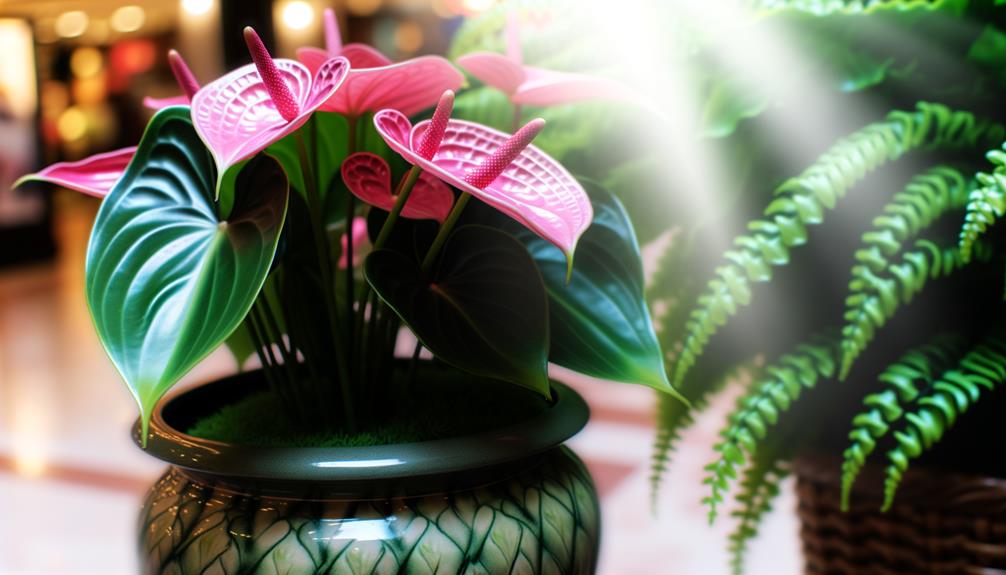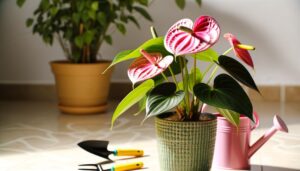Caring for Your Flamingo Plant: Anthurium Pink Champion
To care for Anthurium 'Pink Champion', provide well-draining soil made up of orchid bark, peat moss, and perlite. Water using tepid, dechlorinated water, allowing the top inch of soil to dry between watering.
Position the plant in bright, indirect light, avoiding direct sunlight, and maintain temperatures between 65°F to 80°F. Maintain humidity levels between 60-80%, using humidifiers if necessary.
Prune yellowed leaves with sterilized shears and repot every 2-3 years in spring. For pest control, apply insecticidal soap or neem oil as needed.
With proper care, your Anthurium will flourish, offering vibrant blooms and healthy foliage. Discover additional intricacies crucial for thriving Anthuriums.

Key Takeaways
- Water when the top inch of soil is dry, using tepid, dechlorinated water.
- Position in bright, indirect light; avoid direct sunlight to prevent leaf scorch.
- Maintain moderate humidity levels between 60-80% during the growing season.
- Use a well-draining soil mix with orchid bark, peat moss, and perlite.
- Repot every 2-3 years in spring to support active growth.
Watering Needs
Understanding the exact watering needs of the Flamingo Plant (Anthurium andraeanum) is essential for maintaining its health and vibrant appearance. This tropical plant thrives in well-draining soil with consistent moisture levels, but it is sensitive to overwatering, which can lead to root rot.
Optimal irrigation involves allowing the top inch of the potting medium to dry out before re-watering. Employing tepid, dechlorinated water can prevent mineral buildup and foliage damage.
During the active growing season, typically spring through early fall, maintaining moderate humidity levels between 60-80% enhances hydration through transpiration. Additionally, incorporating a balanced liquid fertilizer bi-monthly during this period supports nutrient absorption.
These precise watering practices ensure Anthurium andraeanum's robust growth and striking floral displays.
Light Requirements
Anthurium andraeanum, commonly known as the Flamingo Plant, requires specific light conditions to thrive at its best. It necessitates bright, indirect light to maintain its vibrant foliage and promote healthy growth, while direct sunlight should be avoided as it can cause leaf scorching.
Positioning the plant near east or north-facing windows typically provides the perfect light exposure.
Optimal Sunlight Exposure
Proper sunlight exposure is necessary for the best growth of Anthurium andraeanum, with bright, indirect light being ideal to prevent leaf scorch and promote healthy blooming. This photophilic species thrives in environments that mimic its native tropical habitats, where sunlight is diffused through the forest canopy.
Positioning the plant near an east or north-facing window provides best light intensity, translating to approximately 10,000-20,000 lux. Avoid placing the Flamingo Plant in areas with insufficient light, as this can impede photosynthesis, leading to leggy growth and reduced flowering.
For indoor cultivation, artificial grow lights can supplement natural light, ensuring the plant receives the necessary 12-14 hours of consistent illumination. Proper light management is optimal for maintaining Anthurium's vibrant foliage and inflorescences.
Avoid Direct Sunlight
Direct exposure to intense sunlight can cause photodamage to the leaves of Anthurium andraeanum, resulting in leaf burn and chlorosis. This species, known commonly as the Flamingo Plant, thrives in bright, indirect light conditions. Ideal placement includes east or north-facing windows, where sunlight is diffused. Should direct sunlight be unavoidable, the use of sheer curtains or shade cloths can lessen potential harm.
Excessive light intensity accelerates the breakdown of chlorophyll, leading to decreased photosynthetic efficiency and compromised plant health. Monitoring light levels with a light meter, maintaining readings between 10,000 to 20,000 lux, ensures the Anthurium Pink Champion achieves robust growth while protecting against photodamage. Regularly rotating the plant will also encourage even light distribution.
Ideal Soil Type
For best growth, Anthurium andraeanum requires a well-draining soil mix to prevent root rot and guarantee sufficient aeration.
A combination of orchid bark, peat moss, and perlite is recommended to maintain a balanced moisture level.
The inclusion of organic matter is essential, as it enhances nutrient availability and supports healthy root development.
Well-Draining Soil Mix
A well-draining soil mix for Anthurium andraeanum, commonly known as the Flamingo Plant, should consist of a blend of peat moss, pine bark, and perlite to guarantee ideal aeration and moisture retention.
Peat moss (Sphagnum spp.) offers excellent water retention and acidity, essential for nutrient uptake.
Pine bark (Pinus spp.) facilitates air circulation within the root zone, promoting healthy root development.
Perlite, a volcanic glass, enhances drainage and prevents soil compaction, thereby reducing the risk of root rot.
The best ratio for this mix is approximately 2:1:1 (peat moss: pine bark: perlite). This combination allows for a balance of moisture and oxygen, replicating the plant's natural epiphytic environment, and ensuring robust growth and vibrant blooms.
Organic Matter Importance
Incorporating organic material into the soil blend is crucial for Anthurium andraeanum. It improves nutrient availability, encourages beneficial microbial activity, and enhances soil structure.
Organic material, such as decomposed bark or peat moss, offers a slow-release supply of necessary nutrients, including nitrogen, phosphorus, and potassium, which are vital for strong plant growth.
Furthermore, organic material supports a flourishing microbial community that aids in nutrient circulation and disease control.
The ideal soil blend should include a well-rounded mix of organic material, perlite, and orchid bark to guarantee optimal aeration and moisture retention.
This combination mirrors the plant's natural epiphytic environment, enabling the roots to obtain ample oxygen while preserving adequate hydration levels.
Temperature Preferences
Anthurium andraeanum, commonly known as the Flamingo Plant, thrives in temperatures ranging from 65°F to 80°F (18°C to 27°C) to maintain ideal growth and health. This species demonstrates peak physiological functions within this thermal range, including photosynthesis and respiration.
Exposure to temperatures below 60°F (15°C) can lead to stunted growth and increased susceptibility to diseases, while temperatures exceeding 85°F (29°C) may induce heat stress, resulting in foliar damage and reduced floral longevity. Consistency in temperature is paramount, as fluctuations can disrupt metabolic processes.
For indoor cultivation, maintaining a stable environment with appropriate thermal regulation is recommended to optimize the Anthurium Pink Champion performs at its peak, thereby exhibiting vibrant spathes and robust foliage.
Humidity Levels
While stable temperatures are important, maintaining appropriate moisture levels is equally essential for the best health of Anthurium andraeanum. This species, commonly referred to as the Flamingo Plant, thrives in environments with humidity levels ranging from 60% to 80%.
Insufficient moisture can lead to leaf browning and reduced growth rates. To achieve ideal conditions, consider using a humidifier or placing the plant on a moisture tray filled with water and pebbles. Additionally, regularly misting the foliage with distilled water can help maintain sufficient moisture levels. Avoid direct water contact with flowers to prevent potential damage.
Monitoring moisture using a hygrometer ensures precise environmental control, promoting the robust health and vibrant blooms characteristic of Anthurium Pink Champion.
Fertilizing Schedule
To optimize the growth and flowering of Anthurium andraeanum, it is crucial to implement a regular fertilizing schedule tailored to its specific nutritional needs. Employ a balanced, water-soluble fertilizer with a 20-20-20 NPK ratio, diluted to half strength, and apply biweekly during the growing season (spring through early autumn).
During the dormant period (late autumn to winter), reduce fertilization to once a month. Guarantee the soil pH remains between 5.5 and 6.5 to facilitate nutrient absorption. Excessive fertilization can lead to salt buildup, causing root damage.
Always water the plant thoroughly before and after fertilizing to prevent root burn. Monitoring nutrient levels and adjusting as necessary will promote vibrant blooms and robust foliage.
Pruning Tips
Proper trimming of Anthurium andraeanum is crucial for maintaining the plant's health, promoting new growth, and preventing disease.
Begin by sterilizing your trimming shears with a solution of 70% isopropyl alcohol to prevent pathogen transmission. Remove any yellowed, withered, or diseased leaves at their base using clean cuts. Additionally, trim spent inflorescences to encourage continuous blooming. Always cut just above a node or leaf junction to facilitate ideal regrowth.
Trim during the active growing season, typically spring and summer, when the plant is most resilient to stress. Regularly inspect the plant for overcrowded foliage, thinning as necessary to improve air circulation and light penetration.
Proper trimming practices will ensure a strong and aesthetically pleasing Anthurium Pink Champion.
Common Pests
Common pests affecting Flamingo plants (Anthurium spp.) include spider mites (Tetranychus urticae), aphids (Aphididae), and mealybugs (Pseudococcidae).
Identifying these pests early is vital for implementing effective pest control measures, such as the use of insecticidal soaps or neem oil (Azadirachta indica).
Regular monitoring and maintaining ideal humidity levels can greatly reduce the incidence of infestations.
Identifying Common Pests
Flamingo plants, scientifically known as *Anthurium andraeanum*, are susceptible to several common pests, including aphids (*Aphidoidea*), spider mites (*Tetranychidae*), and mealybugs (*Pseudococcidae*). Aphids are small, soft-bodied insects that extract sap from plant tissues, leading to distorted growth and reduced vigor.
Spider mites, minute arachnids, inhabit the undersides of leaves, producing fine webbing and causing stippling or yellowing of foliage. Mealybugs, identifiable by their white cottony masses, colonize leaf nodes and stems, excreting honeydew that attracts sooty mold.
Recognizing these pests promptly is crucial, as they can compromise plant health by weakening structural integrity and diminishing photosynthetic efficiency. Accurate identification enables timely intervention, ensuring the health and longevity of *Anthurium Pink Champion*.
Effective Pest Control
Effective pest control for *Anthurium andraeanum* involves a multifaceted approach that includes cultural, mechanical, biological, and chemical methods. Culturally, maintaining ideal humidity (60-80%) and avoiding waterlogged soil can deter *Pseudococcus longispinus* (mealybugs).
Mechanically, manual removal of *Tetranychus urticae* (spider mites) using a damp cloth is effective.
Biologically, introducing natural predators such as *Phytoseiulus persimilis* for spider mites and *Cryptolaemus montrouzieri* for mealybugs can provide sustainable control.
Chemically, insecticidal soaps and neem oil are suitable for minor infestations, while systemic insecticides containing imidacloprid can be used for severe cases.
Regular monitoring and integrated pest management strategies promote healthy *Anthurium* plants free from common pests.
Repotting Guide
Repotting Anthurium andraeanum, commonly known as the Flamingo Plant, should be performed every 2-3 years to promote growth and health. Select a pot that is 1-2 inches larger in diameter than the current one. Utilize a well-draining, aerated potting mix, ideally consisting of orchid bark, perlite, and peat moss. Repotting is best conducted during the spring when the plant exhibits active growth. Make sure the roots are not overly compacted, and trim any damaged sections. Water thoroughly post-repotting to settle the substrate.
| Material | Proportion | Purpose |
|---|---|---|
| Orchid Bark | 40% | Aeration |
| Perlite | 30% | Drainage |
| Peat Moss | 30% | Moisture Retention |
This regimen ensures ideal environmental conditions for Anthurium andraeanum.
Propagation Methods
Propagation of Anthurium andraeanum can be effectively achieved through division or stem cuttings, ensuring genetic consistency and promoting vigorous growth. Division involves separating rooted offsets from the parent plant, preferably during repotting. Each division should have at least one healthy stem and a sufficient root system.
Stem cuttings, taken from the plant's base, should be approximately 6-8 inches in length and include at least two nodes. These cuttings can be rooted in a well-draining, sterile medium such as perlite or a peat-perlite mix. Maintain high humidity and indirect light to facilitate rooting. Both methods benefit from the application of a rooting hormone to enhance success rates.
Proper sanitation is essential to prevent pathogen transmission during propagation activities.
Conclusion
To sum up, best care for Anthurium Pink Champion necessitates precise attention to its:
- Watering needs
- Light requirements
- Soil type
- Temperature
- Humidity levels.
Pruning and pest management are critical for maintaining plant health. Repotting and propagation should be conducted with meticulous care.
Like a vigilant guardian, one must be ever-watchful to guarantee this exquisite specimen thrives, revealing its vibrant beauty and contributing to the diverse tapestry of indoor horticulture.






